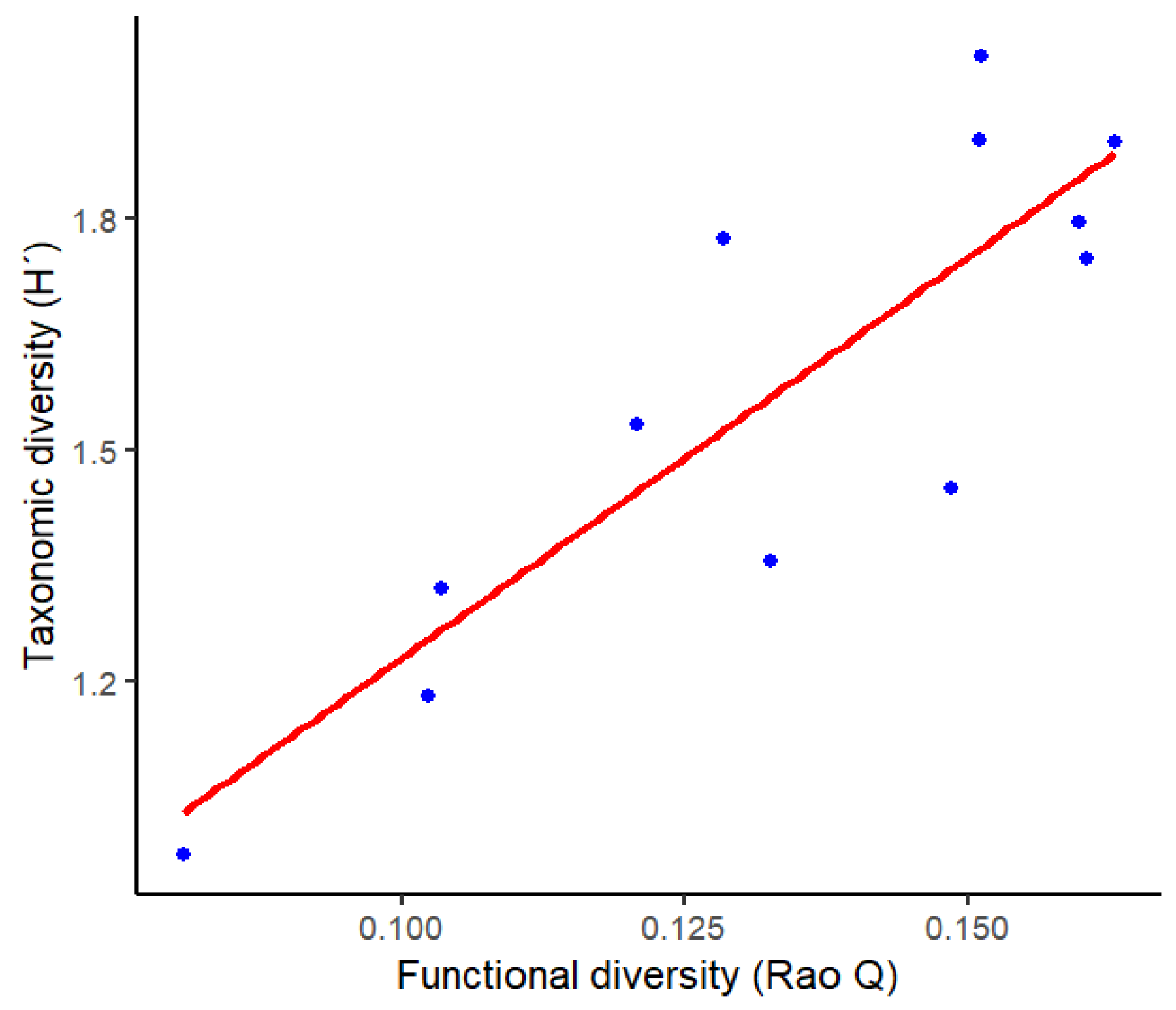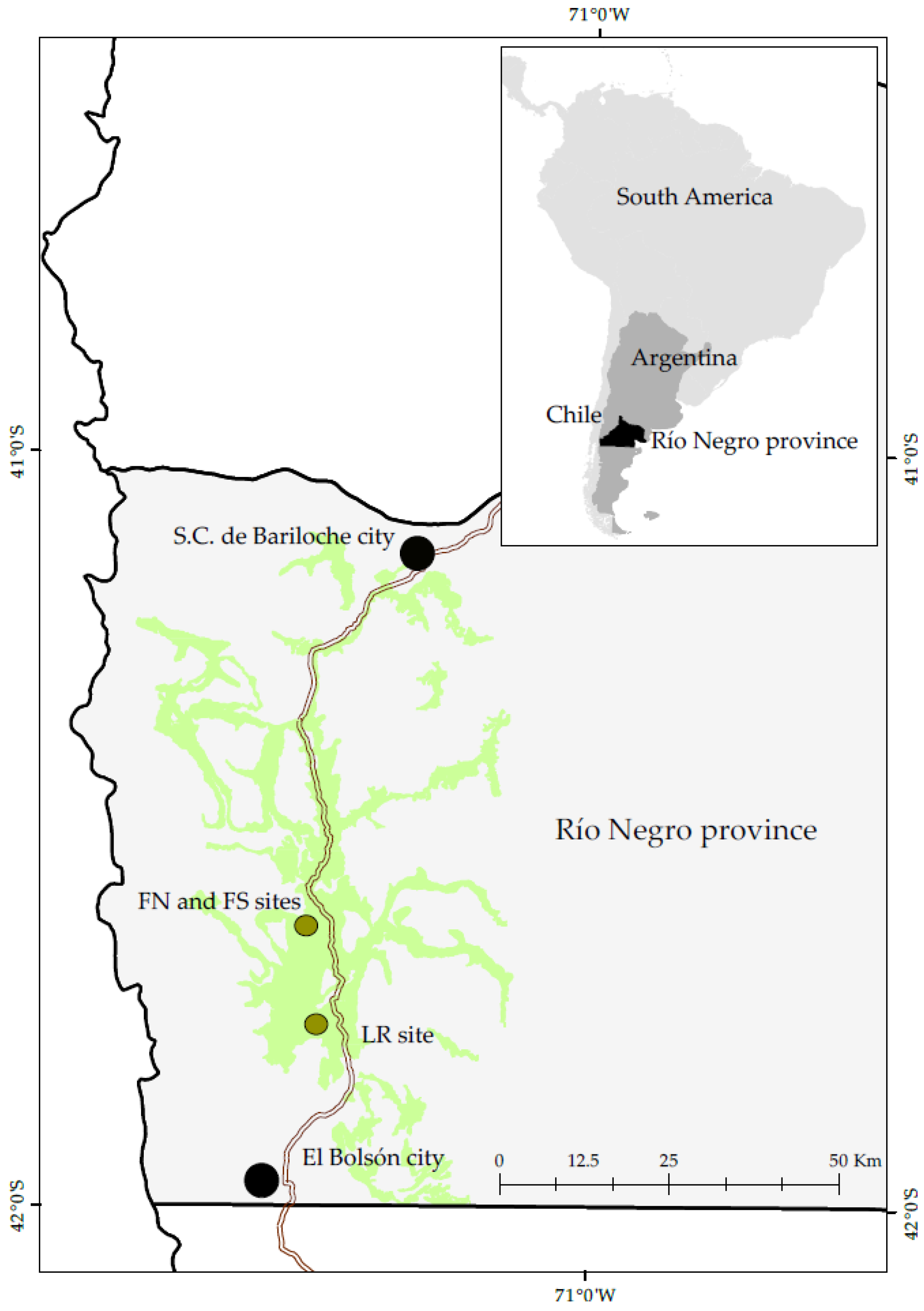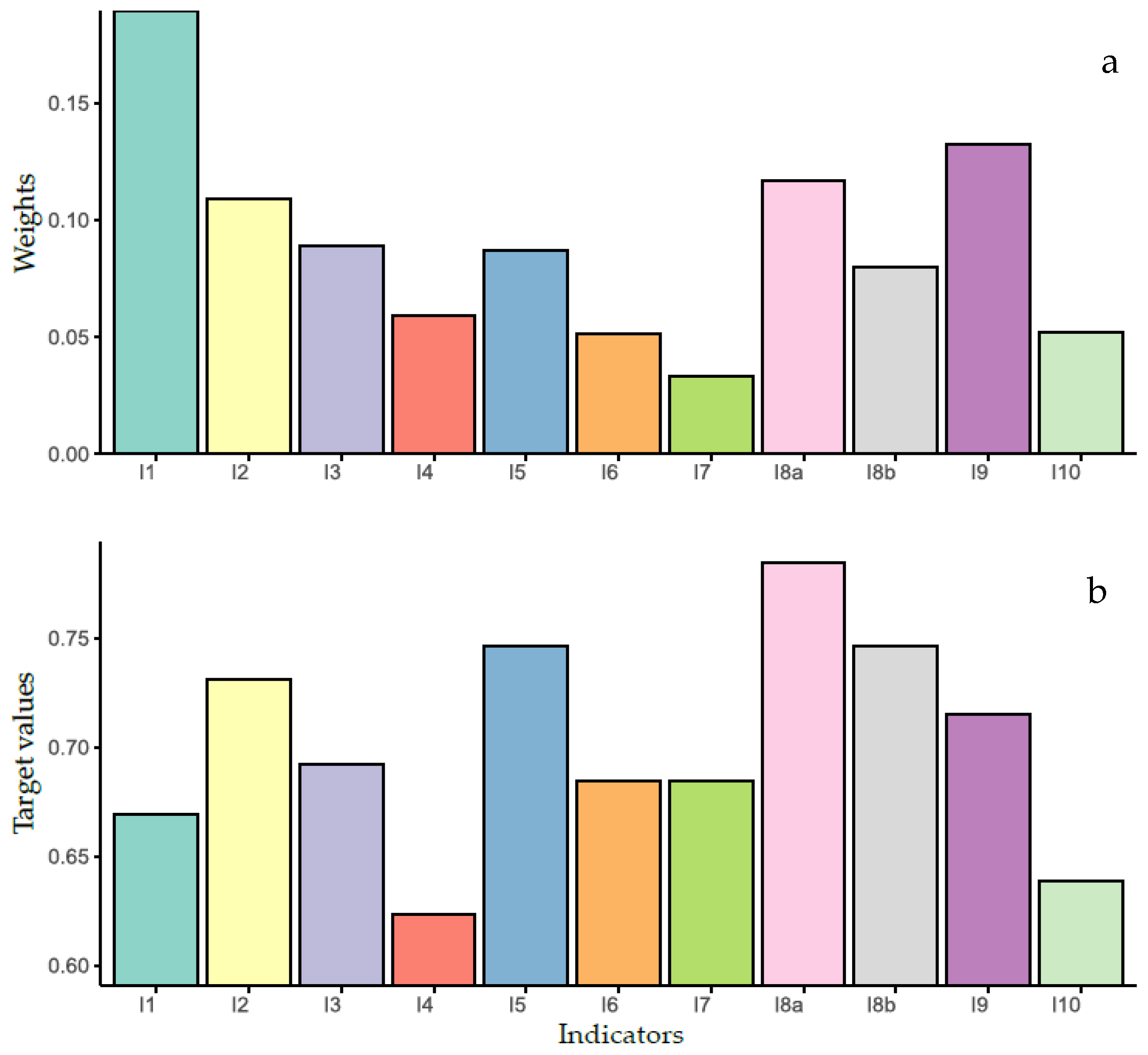Silviculture Promotes Sustainability in Nothofagus antarctica Secondary Forests of Northern Patagonia, Argentina: A Multicriteria Analysis
Abstract
1. Introduction
2. Materials and Methods
2.1. Experiment and Data
2.2. Dimensions and Indicators
2.3. MCDA Approach—Extended Goal Programming Model
Weights, Target Values, and Scenarios
3. Results
4. Discussion
5. Conclusions
Author Contributions
Funding
Data Availability Statement
Conflicts of Interest
Abbreviations
| NCP | Nature’s contributions to people |
| MCDA | Multi criteria decision analysis |
| GP | Goal Programming |
| EGP | Extended Goal Programming |
| DM | Decision makers |
| NO | No cutting |
| LOW | Low cutting intensity |
| MID | Medium cutting intensity |
| HI | High cutting intensity |
Appendix A
| Indicator | Type | NCP Category | References |
|---|---|---|---|
| Firewood harvesting (m3 ha−1) | + | Energy (NCP 11) | [16] |
| Wood production (% survival of afforestation) | + | Provision of materials (NCP 13) | [23] |
| Pollinators diversity (Chao 1) | + | Maintenance of options (NCP 18) | [15] |
| Folivorous arthropods diversity (H’) | + | [29] | |
| Plant taxonomic diversity (H’) | + | [29] | |
| Plant functional diversity (Rao Q) | + | [28] | |
| Litter production (m2 ha−1) | + | Formation, protection of soils (NCP 8) | [25] |
| Litter decomposition (% o.m.r.) | + | [27] | |
| Fire prevention | Regulation of hazards (NCP 9) | [25] | |
| Live fuel continuity (m2 ha−1) | (−) | ||
| Live fuel moisture content (%) | (+) | ||
| Invasibility (% exotic pines germination) | − | Regulation of detrimental organisms and biological processes (NCP 10) | [30] |
| Folivory (% leaf damage) | − | [29] |


References
- Achim, A.; Moreau, G.; Coops, N.C.; Axelson, J.N.; Barrette, J.; Bédard, S.; Byrne, K.E.; Caspersen, J.; Dick, A.R.; D’Orangeville, L.; et al. The changing culture of silviculture. For. Int. J. For. Res. 2021, 95, 143–152. [Google Scholar] [CrossRef]
- O’Hara, K.L. What is close-to-nature silviculture in a changing world? For. Int. J. For. Res. 2015, 89, 1–6. [Google Scholar] [CrossRef]
- Fabbio, G.; Cantiani, P.; Ferretti, F.; Di Salvatore, U.; Bertini, G.; Becagli, C.; Chiavetta, U.; Marchi, M.; Salvati, L. Sustainable Land Management, Adaptive Silviculture, and New Forest Challenges: Evidence from a Latitudinal Gradient in Italy. Sustainability 2018, 10, 2520. [Google Scholar] [CrossRef]
- Díaz, S.; Pascual, U.; Stenseke, M.; Martín-López, B.; Watson, R.T.; Molnár, Z.; Hill, R.; Chan, K.M.A.; Baste, I.A.; Brauman, K.A.; et al. Assessing nature’s contributions to people. Science 2018, 359, 270–272. [Google Scholar] [CrossRef]
- Díaz-Yáñez, O.; Pukkala, T.; Packalen, P.; Lexer, M.J.; Peltola, H. Multi-objective forestry increases the production of ecosystem services. For. Int. J. For. Res. 2020, 94, 386–394. [Google Scholar] [CrossRef]
- Kangas, J.; Kangas, A. Multiple criteria decision support in forest management: The approach, methods applied, and experiences gained. For. Ecol. Manag. 2005, 207, 133–143. [Google Scholar] [CrossRef]
- Ananda, J.; Herath, G.A. Critical Review of Multi-Criteria Decision Making Methods with Special Reference to Forest Management and Planning. Ecol. Econ. 2009, 68, 2535–2548. [Google Scholar] [CrossRef]
- Marques, M.; Reynolds, K.M.; Marto, M.; Lakicevic, M.; Caldas, C.; Murphy, P.J.; Borges, J.G. Multicriteria decision analysis and group Decision-Making to select Stand-Level forest management models and support Landscape-Level collaborative planning. Forests 2021, 12, 399. [Google Scholar] [CrossRef]
- Mendoza, G.A.; Martins, H. Multi-criteria decision analysis in natural resource management: A critical review of methods and new modelling paradigms. For. Ecol. Manag. 2006, 230, 1–22. [Google Scholar] [CrossRef]
- Kpadé, C.P.; Tamini, L.D.; Pepin, S.; Khasa, D.P.; Abbas, Y.; Lamhamedi, M.S. Evaluating Multi-Criteria Decision-Making Methods for Sustainable Management of Forest Ecosystems: A Systematic Review. Forests 2024, 15, 1728. [Google Scholar] [CrossRef]
- Carabelli, E.; Bigsby, H.R.; Cullen, R.; Peri, P.L. Measuring Sustainable Forest Management in Tierra del Fuego, Argentina. J. Sustain. For. 2007, 24, 85–108. [Google Scholar] [CrossRef]
- Diaz-Balteiro, L.; Voces, R.; Romero, C. Making Sustainability Rankings Using Compromise Programming. An Application to European Paper Industry. Silva Fenn. 2011, 45, 761–773. [Google Scholar] [CrossRef]
- CIEFAP y MAyDS. Actualización de la Clasificación de Tipos Forestales y Cobertura del Suelo de la Región Bosque Andino Patagónico. Informe Final; CIEFAP: Buenos Aires, Argentina, 2016; p. 111. [Google Scholar]
- Reque, J.A.; Sarasola, M.; Gyenge, J.; Fernández, M.E. Caracterización silvícola de ñirantales del norte de la Patagonia para la gestión forestal sostenible. Bosque 2007, 28, 33–45. [Google Scholar] [CrossRef]
- Coulin, C.; Aizen, M.A.; Garibaldi, L.A. Contrasting responses of plants and pollinators to woodland disturbance. Austral Ecol. 2019, 44, 1040–1051. [Google Scholar] [CrossRef]
- Goldenberg, M.G.; Oddi, F.J.; Amoroso, M.M.; Garibaldi, L.A. Effects of harvesting intensity and site conditions on biomass production of northern Patagonia shrublands. Eur. J. For. Res. 2020, 139, 881–891. [Google Scholar] [CrossRef]
- Tiribelli, F.; Kitzberger, T.; Morales, J.M. Changes in vegetation structure and fuel characteristics along post-fire succession promote alternative stable states and positive fire–vegetation feedbacks. J. Veg. Sci. 2018, 29, 147–156. [Google Scholar] [CrossRef]
- Morales, J.M.; Mermoz, M.; Gowda, J.H.; Kitzberger, T. A stochastic fire spread model for north Patagonia based on fire occurrence maps. Ecol. Model. 2015, 300, 73–80. [Google Scholar] [CrossRef]
- Landesmann, J.B.; Gowda, J.H.; Kitzberger, T. Temporal shifts in the interaction between woody resprouters and an obligate seeder tree during a post-fire succession in Patagonia. J. Veg. Sci. 2016, 27, 1198–1208. [Google Scholar] [CrossRef]
- Grosfeld, J.; Chauchard, L.; Gowda, J.H. Debates: ¿Podemos manejar sustentablemente el bosque nativo de Patagonia Norte? Ecol. Aust. 2019, 29, 156–163. [Google Scholar] [CrossRef]
- Gowda, J.H.; Kitzberger, T.; Musso, R.G. Modelos de cambio en cobertura forestal de la cuenca del río Manso inferior ¿Una herramienta para definir estrategias de manejo? Bosque 2023, 44, 273–284. [Google Scholar] [CrossRef]
- Paritsis, J. Short-stature trees: Need for expanded knowledge on stand dynamics for their ecological and silvicultural management. J. Appl. Ecol. 2024, 61, 1496–1499. [Google Scholar] [CrossRef]
- Nacif, M.E.; Goldenberg, M.G.; Oddi, F.J.; Pastorino, M.J.; Aparicio, A.G.; Garibaldi, L.A. Plantación de especies forestales nativas en matorrales de Patagonia norte: Respuesta a la apertura inicial de dosel en sitios contrastantes. Bosque 2023, 44, 219–239. [Google Scholar] [CrossRef]
- Diaz-Balteiro, L.; Belavenutti, P.; Ezquerro, M.; González-Pachón, J.; Nobre, S.R.; Romero, C. Measuring the sustainability of a natural system by using multi-criteria distance function methods: Some critical issues. J. Environ. Manag. 2018, 214, 197–203. [Google Scholar] [CrossRef] [PubMed]
- Goldenberg, M.G.; Oddi, F.J.; Gowda, J.H.; Garibaldi, L.A. Effects of firewood harvesting intensity on biodiversity and ecosystem services in shrublands of northern Patagonia. For. Ecosyst. 2020, 7, 47. [Google Scholar] [CrossRef]
- Gyenge, J.; Fernández, M.E.; Fernández, M.E.; Sarasola, M.; de Urquiza, M.; Schlichter, T. Ecuaciones para la estimación de biomasa aérea y volumen de fuste de algunas especies leñosas nativas en el valle del río Foyel, NO de la Patagonia argentina. Bosque 2009, 30, 95–101. [Google Scholar] [CrossRef]
- Nabaes Jodar, D.N.; García, I.M.; Goldenberg, M.G.; Garibaldi, L.A. Producción de restos vegetales y descomposición de hojarasca foliar bajo distintas intensidades de corta en fajas en matorrales. Ecol. Aust. 2023, 33, 178–187. [Google Scholar] [CrossRef]
- Chillo, V.; Goldenberg, M.; Pérez-Méndez, N.; Garibaldi, L.A. Diversity, functionality, and resilience under increasing harvesting intensities in woodlands of northern Patagonia. For. Ecol. Manag. 2020, 474, 118349. [Google Scholar] [CrossRef]
- Nacif, M.E.; Quintero, C.; Garibaldi, L.A. Intermediate harvesting intensities enhance native tree performance of contrasting species while conserving herbivore diversity in a Patagonian woodland. For. Ecol. Manag. 2020, 483, 118719. [Google Scholar] [CrossRef]
- Dimarco, R.D.; Nacif, M.E.; Garibaldi, L.A.; Nuñez, M.A. Higher establishment of nonnative trees with increased harvest intensity in strip cuttings. New For. 2024, 55, 1439–1453. [Google Scholar] [CrossRef]
- Goldenberg, M.G.; Nacif, M.E.; Oddi, F.J.; Garibaldi, L.A. Early response of Nothofagus antarctica forests to thinning intensity in northern Patagonia. Can. J. For. Res. 2020, 51, 493–499. [Google Scholar] [CrossRef]
- Erol, I.; Sencer, S.; Sari, R. A new fuzzy multi-criteria framework for measuring sustainability performance of a supply chain. Ecol. Econ. 2011, 70, 1088–1100. [Google Scholar] [CrossRef]
- Diaz-Balteiro, L.; Romero, C. In search of a natural systems sustainability index. Ecol. Econ. 2004, 49, 401–405. [Google Scholar] [CrossRef]
- Romero, C. Extended lexicographic goal programming: A unifying approach. Omega 2001, 29, 63–71. [Google Scholar] [CrossRef]
- Diaz-Balteiro, L.; Alonso, R.; Martínez-Jaúregui, M.; Pardos, M. Selecting the best forest management alternative by aggregating ecosystem services indicators over time: A case study in central Spain. Ecol. Indic. 2017, 72, 322–329. [Google Scholar] [CrossRef]
- Ezquerro, M.; Diaz-Balteiro, L.; Pardos, M. Implications of forest management on the conservation of protected areas: A new proposal in Central Spain. For. Ecol. Manag. 2023, 548, 121428. [Google Scholar] [CrossRef]
- Ezquerro, M.; Pardos, M.; Diaz-Balteiro, L. Integrating variable retention systems into strategic forest management to deal with conservation biodiversity objectives. For. Ecol. Manag. 2019, 433, 585–593. [Google Scholar] [CrossRef]
- Lindo Systems, Inc. LINGO; (Version 21.0); Lindo Systems, Inc.: Chicago, IL, USA, EE.UU; 2024; Available online: https://www.lindo.com/ (accessed on 1 September 2024).
- Saaty, T.L. The Analytic Hierarchy Process: Planning, Priority Setting, Resource Allocation, 2nd ed.; McGraw-Hill: New York, NY, USA, 1980; p. 287. [Google Scholar]
- Saaty, T.L. A scaling method for priorities in hierarchical structures. J. Math. Psychol. 1977, 15, 234–281. [Google Scholar] [CrossRef]
- Diaz-Balteiro, L.; Rodriguez, L.C. Optimal rotations on Eucalyptus plantations including carbon sequestration—A comparison of results in Brazil and Spain. For. Ecol. Manag. 2006, 229, 247–258. [Google Scholar] [CrossRef]
- Grammatikopoulou, I.; Vačkářová, D. The value of forest ecosystem services: A meta-analysis at the European scale and application to national ecosystem accounting. Ecosyst. Serv. 2021, 48, 101262. [Google Scholar] [CrossRef]
- Kitzberger, T.; Tiribelli, F.; Barberá, I.; Gowda, J.H.; Morales, J.M.; Zalazar, L.; Paritsis, J. Projections of fire probability and ecosystem vulnerability under 21st century climate across a trans-Andean productivity gradient in Patagonia. Sci. Total Environ. 2022, 839, 156303. [Google Scholar] [CrossRef]
- Grilli, G.; Nikodinoska, N.; Paletto, A.; De Meo, I. Stakeholders’ Preferences and Economic Value of Forest Ecosystem Services: An Example in the Italian Alps. Balt. For. 2015, 21, 298–307. Available online: https://www.cabdirect.org/cabdirect/abstract/20163062277 (accessed on 7 October 2024).
- Franzese, J.; Raffaele, E.; Chiuffo, M.C.; Blackhall, M. The legacy of pine introduction threatens the fuel traits of Patagonian native forests. Biol. Conserv. 2022, 267, 109472. [Google Scholar] [CrossRef]
- Raffaele, E.; Nuñez, M.A.; Eneström, J.; Blackhall, M. Fire as mediator of pine invasion: Evidence from Patagonia, Argentina. Biol. Invasions 2015, 18, 597–601. [Google Scholar] [CrossRef]
- Franzese, J.; Urrutia, J.; García, R.A.; Taylor, K.; Pauchard, A. Pine invasion impacts on plant diversity in Patagonia: Invader size and invaded habitat matter. Biol. Invasions 2016, 19, 1015–1027. [Google Scholar] [CrossRef]
- Rusch, V.E.; López, D.R.; Cavallero, L.; Rusch, G.M.; Garibaldi, L.A.; Grosfeld, J.; Peri, P. Modelo de estados y transiciones de los ñirantales del NO de la Patagonia como herramienta para el uso silvopastoril sustentable. Ecol. Aust. 2016, 27, 266–278. [Google Scholar] [CrossRef]
- Tognetti, R.; Smith, M.; Panzacchi, P. An introduction to Climate-Smart forestry in mountain regions. In Managing Forest Ecosystems; Springer: Berlin/Heidelberg, Germany, 2021; pp. 1–33. [Google Scholar] [CrossRef]
- Batjes, N.H. Total carbon and nitrogen in the soils of the world. Eur. J. Soil Sci. 1996, 47, 157–163. [Google Scholar] [CrossRef]
- Ameray, A.; Bergeron, Y.; Valeria, O.; Montoro Girona, M.; Cavard, X. Forest carbon management: A review of silvicultural practices and management strategies across boreal, temperate and tropical forests. Curr. For. Rep. 2021, 7, 245–266. [Google Scholar] [CrossRef]
- Loguercio, G.A.; Simon, A.; Winter, A.N.; Ivancich, H.; Reiter, E.J.; Caselli, M.; Heinzle, F.G.; Leuschner, C.; Walentowski, H. Carbon density and sequestration in the temperate forests of northern Patagonia, Argentina. Front. For. Glob. Change 2024, 7, 1373187. [Google Scholar] [CrossRef]
- Chillo, V.; Ladio, A.H.; Salinas Sanhueza, J.; Soler, R.; Arpigiani, D.F.; Rezzano, C.A.; Cardozo, A.G.; Peri, P.; Amoroso, M.M. Silvopastoral Systems in Northern Argentine-Chilean Andean Patagonia: Ecosystem Services Provision in a Complex Territory. In Ecosystem Services in Patagonia, Natural and Social Sciences of Patagonia; Springer: Berlin/Heidelberg, Germany, 2021; pp. 115–137. [Google Scholar] [CrossRef]


| Indicator | Type | NCP Category | NCP Dimension |
|---|---|---|---|
| (I1) Firewood harvesting (m3 ha−1) | (+) | Energy (NCP 11) | Material |
| (I2) Wood production (% survival of afforestation) | (+) | Provision of materials (NCP 13) | |
| (I3) Pollinators diversity (Chao 1) | (+) | Maintenance of options (NCP 18) | |
| (I4) Folivorous arthropods diversity (H’) | (+) | Non-material | |
| (I5) Plant taxonomic diversity (H’) | (+) | ||
| (I6) Litter production (m2 ha−1) | (+) | Formation and protection of soils (NCP 8) | Regulating |
| (I7) Litter decomposition (% o.m.r.) | (+) | ||
| (I8) Fire prevention | Regulation of hazards (NCP 9) | ||
| (I8a) Live fuel continuity (m2 ha−1) | (−) | ||
| (I8b) Live fuel moisture content (%) | (+) | ||
| (I9) Invasibility (% exotic pines germination) | (−) | Regulation of detrimental organisms and biological processes (NCP 10) | |
| (I10) Folivory (% leaf damage) | (−) |
| Site | SCI | I1 | I2 | I3 | I4 | I5 | I6 | I7 | I8a | I8b | I9 | I10 |
|---|---|---|---|---|---|---|---|---|---|---|---|---|
| FS | NO | 0.000 | 0.192 | 0.000 | 0.000 | 0.000 | 1.000 | 0.000 | 0.000 | 1.000 | 1.000 | 1.000 |
| LOW | 0.429 | 1.000 | 0.048 | 1.000 | 0.413 | 0.735 | 0.834 | 0.429 | 0.571 | 0.745 | 0.032 | |
| MID | 0.714 | 0.797 | 0.397 | 0.900 | 0.638 | 0.422 | 1.000 | 0.714 | 0.286 | 0.427 | 0.000 | |
| HI | 1.000 | 0.000 | 1.000 | 0.100 | 1.000 | 0.000 | 0.857 | 1.000 | 0.000 | 0.000 | 0.458 | |
| FN | NO | 0.000 | 0.763 | 0.000 | 0.000 | 0.000 | 1.000 | 1.000 | 0.000 | 1.000 | 1.000 | 1.000 |
| LOW | 0.429 | 1.000 | 0.048 | 1.000 | 0.875 | 0.735 | 0.000 | 0.429 | 0.571 | 0.745 | 0.032 | |
| MID | 0.714 | 0.688 | 0.397 | 0.889 | 1.000 | 0.422 | 0.139 | 0.714 | 0.286 | 0.427 | 0.000 | |
| HI | 1.000 | 0.000 | 1.000 | 0.111 | 0.625 | 0.000 | 0.923 | 1.000 | 0.000 | 0.000 | 0.458 | |
| LR | NO | 0.000 | 0.000 | 0.000 | 0.000 | 0.960 | 1.000 | 1.000 | 0.000 | 1.000 | 1.000 | 1.000 |
| LOW | 0.429 | 0.000 | 0.048 | 1.000 | 1.000 | 0.735 | 0.000 | 0.429 | 0.571 | 0.745 | 0.032 | |
| MID | 0.714 | 0.000 | 0.397 | 0.889 | 0.657 | 0.422 | 0.030 | 0.714 | 0.286 | 0.427 | 0.000 | |
| HI | 1.000 | 0.000 | 1.000 | 0.000 | 0.000 | 0.000 | 0.617 | 1.000 | 0.000 | 0.000 | 0.458 |
| FS and FN | LR | |||||||||
|---|---|---|---|---|---|---|---|---|---|---|
| Rank | = 1 | = 0 | = 0.5 | = 0.5P | = 0.5C | = 1 | = 0 | = 0.5 | = 0.5P | = 0.5C |
| 1 | MID | MID | MID | MID | MID | MID | MID | MID | MID | MID |
| 2 | LOW | LOW | LOW | LOW | LOW | LOW | LOW | LOW | HI | LOW |
| 3 | HI | HI | HI | HI | HI | HI | HI | HI | LOW | NO |
| 4 | NO | NO | NO | NO | NO | NO | NO | NO | NO | HI |
Disclaimer/Publisher’s Note: The statements, opinions and data contained in all publications are solely those of the individual author(s) and contributor(s) and not of MDPI and/or the editor(s). MDPI and/or the editor(s) disclaim responsibility for any injury to people or property resulting from any ideas, methods, instructions or products referred to in the content. |
© 2025 by the authors. Licensee MDPI, Basel, Switzerland. This article is an open access article distributed under the terms and conditions of the Creative Commons Attribution (CC BY) license (https://creativecommons.org/licenses/by/4.0/).
Share and Cite
Goldenberg, M.G.; Huaylla, C.; Oddi, F.J.; Agüero, J.I.; Nacif, M.E.; Martínez Pastur, G.J.; Garibaldi, L.A. Silviculture Promotes Sustainability in Nothofagus antarctica Secondary Forests of Northern Patagonia, Argentina: A Multicriteria Analysis. Land 2025, 14, 843. https://doi.org/10.3390/land14040843
Goldenberg MG, Huaylla C, Oddi FJ, Agüero JI, Nacif ME, Martínez Pastur GJ, Garibaldi LA. Silviculture Promotes Sustainability in Nothofagus antarctica Secondary Forests of Northern Patagonia, Argentina: A Multicriteria Analysis. Land. 2025; 14(4):843. https://doi.org/10.3390/land14040843
Chicago/Turabian StyleGoldenberg, Matías G., Claudia Huaylla, Facundo J. Oddi, Juan I. Agüero, Marcos E. Nacif, Guillermo J. Martínez Pastur, and Lucas A. Garibaldi. 2025. "Silviculture Promotes Sustainability in Nothofagus antarctica Secondary Forests of Northern Patagonia, Argentina: A Multicriteria Analysis" Land 14, no. 4: 843. https://doi.org/10.3390/land14040843
APA StyleGoldenberg, M. G., Huaylla, C., Oddi, F. J., Agüero, J. I., Nacif, M. E., Martínez Pastur, G. J., & Garibaldi, L. A. (2025). Silviculture Promotes Sustainability in Nothofagus antarctica Secondary Forests of Northern Patagonia, Argentina: A Multicriteria Analysis. Land, 14(4), 843. https://doi.org/10.3390/land14040843







